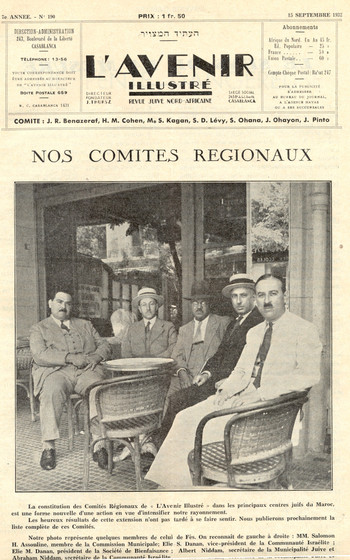L'AVENIR ILLUSTRÉ (REVUE JUIVE NORD-AFRICAINE)
Thursz. J. (Directeur)
| Numéro d'objet: |
3825 |
| Date: |
1929 |
| Genre: |
Journaux |
| Lieu: |
Casablanca |
| Sujet: |
Sociologie / Société |
Recherche dans "Notes":
1926: 8-9-11
1927: 14-15-16-17-19-21
1929:1
1930:17-19-20-21-22-23-24-29-30-31-37-38-39-40-41-42-43-44-45
1931:148-165-170-
1932:176-177-179-187-189-190-191-192-196-197
1933:198-
1934:228-230-232-
1935:236-237-238-239-240-241-242-
1936:256-
1937:258-259-260-261-262-263-264-265-266-267-
1938:269-270-271-272-273-274-275-276-277-278-
1939:281-282-284-285-287
1940:291
L'Avenir Illustré
Frequency: Monthly, 1926-1929; Fortnightly, 1929-1940
Language: French
Period: 1926 - 1940
Country: Morocco
Section: The Jewish Press in Arab Lands Section
Publication Place: Casablanca (Morocco)
Editors: Jonathan Tursz
L'Avenir Illustré was the first long-lasting Jewish newspaper in Morocco. The paper was founded in Morocco while it was under French colonial rule and at the height of the modernization process, and attempted to instill nationalistic Jewish values among the increasingly Westernized elites of the Jewish communities. Its founder and editor was an Ashkenazi Jewish immigrant, Jonathan Thursz (1895-1976), a native of Poland who was educated in Belgium and settled in Morocco in 1923. The colonial authorities disapproved of Zionist activity but were unable to object to the publication of L'Avenir, which avoided a Zionist label and whose editorial board consisted largely of citizens of the European powers who enjoyed their protection. The newspaper opposed the veteran, official Jewish leadership and aimed to consolidate the local youth, French-reading students of the Alliance Israélite Universelle. It sought to encourage public activity for the benefit of local communities, as well as of Jewish concerns worldwide and the Zionist enterprise in Palestine in particular.
The newspaper is an extremely rich source of information about the Jewish communities in Morocco during the period of its publication, and is notable for the large number of photographs and advertisements found in its pages. It particularly reflects the housing and sanitation problems faced by the Jewish community in Casablanca, a burgeoning port city suffering from sudden overpopulation. The newspaper served as a platform for various reform initiatives and opened its doors to some of the first local Jewish journalists, including Yaacov Ohayon (d. 1940). It is difficult to estimate the paper's circulation (there were probably only a few hundred subscribers), but it marked a milestone in the cultural modernization of Moroccan Jews and in the distribution of Jewish nationalist ideology. Some researchers are interested only in the paper's Zionist aspect, but for others -- in particular Hagar Hillel, who carried out significant research on the subject -- it is its internal community profile that stands out, and they prefer to identify it as a nationalist-reformist newspaper.

